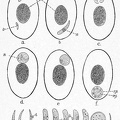A diagram showing the life-history and migration of the Malaria parasite
A diagram showing the life-history and migration of the Malaria parasite, Laverania Malariæ, as discovered by Laveran, Ross, and Grassi. The stages above the dotted line take place in the blood of man. The oblong-pointed parasite is seen entering the blood at n just below No. 1. The circles represent the red blood-discs of man. Schizogony means multiplication by simple division or splitting, and it is seen in Nos. 6, 7, 8, 9, and 10. The stages below the dotted line are passed in the body of the spot-winged gnats of the genus Anopheles. A peculiar crescent or sausage-shaped condition is assumed by the parasite inside the red corpuscle No. VI. These are found to be of two kinds, male and female, Nos. VIIa and VIIb. They are swallowed by the spot-winged gnat when it sucks the blood of an infected man. Here in the gut of the gnat they become spherical; the male spheres produce spermatozoa No. Xa, which fuse with and fertilize the female spheres or egg-cells No. XI. An active worm-like form No. XIII results, which pushes its way partly through the wall of the gnat’s gut, and is then nourished by the gnat’s blood. It swells up, divides internally again and again, and is enclosed in a firm transparent case or cyst, Nos. XIV to XVIII. The cysts are far larger in proportion than is shown in the diagram, and are visible to the naked eye. The final product of the breaking up, which is called sporogony, is a vast number of needle-shaped spores or young (called Exotospores, as opposed to the Enhæmospores, which are formed in the human blood, as seen in Nos. 9 and 10, and serve there to spread the infection among the red corpuscles). The needle-shaped spores formed in the gnat’s body accumulate in its salivary glands, and pass out by the mouth of the gnat when it stabs a new human victim who thus becomes infected, No. XIX.
- Author
- The Kingdom of Man
By Sir E. Ray (Edwin Ray) Lankester
Published 1907
Available from gutenberg.org - Posted on
- Sunday 8 November 2020
- Dimensions
- 713*1059
- Tags
- Albums
- Visits
- 460
- Downloads
- 22
 Download Photo
Download Photo





